5 people were asked about the time in a week they spend in doing social work in their community. They said 10, 7, 13, 20 and 15 hours, respectively. Find the mean (or average) time in a week devoted by them for social work.
To find the mean (or average) time spent by the five people on social work, we can follow these steps:
Step 1: List the hours spent by each person
The hours spent by the five people are:
- Person 1: 10 hours
- Person 2: 7 hours
- Person 3: 13 hours
- Person 4: 20 hours
- Person 5: 15 hours
Step 2: Sum the hours spent
Now, we need to calculate the total hours spent by all five people:
Total hours=10+7+13+20+15
Step 3: Perform the addition
Calculating the sum:
10+7=1717+13=3030+20=5050+15=65
So, the total hours spent is 65 hours.
Step 4: Count the number of observations
The total number of people (observations) is 5.
Step 5: Calculate the mean
To find the mean, we divide the total hours by the number of people:
Mean=Total hoursNumber of people=655
Step 6: Perform the division
Calculating the mean:
655=13
Conclusion
The mean (or average) time in a week devoted by them for social work is 13 hours.
---
The hours spent by the five people are:
- Person 1: 10 hours
- Person 2: 7 hours
- Person 3: 13 hours
- Person 4: 20 hours
- Person 5: 15 hours
Now, we need to calculate the total hours spent by all five people:
Total hours=10+7+13+20+15
Calculating the sum:
10+7=1717+13=3030+20=5050+15=65
So, the total hours spent is 65 hours.
The total number of people (observations) is 5.
To find the mean, we divide the total hours by the number of people:
Mean=Total hoursNumber of people=655
Calculating the mean:
655=13
The mean (or average) time in a week devoted by them for social work is 13 hours.
Similar Questions
A factory makes tennis rackets and cricket bats. A tennis racket takes 1.5 hours of machine time and 3 hours of craftmans time in its making while a cricket bat takes 3 hours of machine time and 1 hour of craftmans time. In a day, the factory has the availability of not more than 42 hours of machine time and 24 hours of craftsmans time. If the profit on a racket and on a bat is Rs. 20 and Rs. 10 respectively, find the number of tennis rackets and crickets bats that the factory must manufacture to earn the maximum profit. Make it as an L.P.P. and solve graphically.
View SolutionA student working with a spring mass system finds the values of mass, spring constant and damping constant in CGS unit as 90,4.5×10+3 and 180 respectively. What will be the time period of the spring mass system ?
View Solution
Knowledge Check
Lennon has 6 hours to spend in Ha Ha Tonka state park. He plants to drive around the park at an average speed of 20 miles per hour, looking for a good trail to hike. Once he finds a trail he likes, he will spend the remainder of his time hiking it. He hopes to travel more than 60 miles total while in the park. If he hikes at an average speed of 1.5 miles per hour, which of the following system of inequalities can be solved for the number of hours Lennon spends driving d, and the number of hours he spends hiking,h, while he is at the park?
A1.5h+20d>60
h+d≤6B1.5h+20d>60
h+d≥6C1.5h+20d<60
h+d≥360D20h+1.5d>6
h+d≤60Every day, millions of shoppers hit the stores in
full force—both online and on foot—searching
frantically for the perfect gift. Last year, Americans
spent over $30 billion at retail stores in the month of
5 December alone. Aside from purchasing holiday
gifts, most people regularly buy presents for other
occasions throughout the year, including weddings,
birthdays, anniversaries, graduations, and baby
showers. This frequent experience of gift-giving can
10 engender ambivalent feelings in gift-givers. Many
relish the opportunity to buy presents because
gift-giving offers a powerful means to build stronger
bonds with one’s closest peers. At the same time,
many dread the thought of buying gifts, they worry
15 that their purchases will disappoint rather than
delight the intended recipients.
Anthropologists describe gift-giving as a positive
social process, serving various political, religious, and
psychological functions. Economists, however, offer
20 a less favorable view. According to Waldfogel (1993),
gift-giving represents an objective waste of resources.
People buy gifts that recipients would not choose to
buy on their own, or at least not spend as much
money to purchase (a phenomenon referred to as
25 ‘‘the deadweight loss of Christmas”). To wit, givers
are likely to spend $100 to purchase a gift that
receivers would spend only $80 to buy themselves.
This ‘‘deadweight loss” suggests that gift-givers are
not very good at predicting what gifts others will
30 appreciate. That in itself is not surprising to social
psychologists. Research has found that people often
struggle to take account of others’ perspectives—
their insights are subject to egocentrism, social
projection, and multiple attribution errors.
35 What is surprising is that gift-givers have
considerable experience acting as both gift-givers and
gift-recipients, but nevertheless tend to overspend
each time they set out to purchase a meaningful gift.
In the present research, we propose a unique
40 psychological explanation for this overspending
problem—i.e., that gift-givers equate how much they
spend with how much recipients will appreciate the
gift (the more expensive the gift, the stronger a
gift-recipient’s feelings of appreciation). Although a
45 link between gift price and feelings of appreciation
might seem intuitive to gift-givers, such an
assumption may be unfounded. Indeed, we propose
that gift-recipients will be less inclined to base their
feelings of appreciation on the magnitude of a gift
50 than givers assume.
Why do gift-givers assume that gift price is closely
linked to gift-recipients’ feelings of appreciation?
Perhaps givers believe that bigger (i.e., more
expensive) gifts convey stronger signals of
55 thoughtfulness and consideration. According to
Camerer (1988) and others, gift-giving represents a
symbolic ritual, whereby gift-givers attempt to signal
their positive attitudes toward the intended recipient
and their willingness to invest resources in a future
60 relationship. In this sense, gift-givers may be
motivated to spend more money on a gift in order to
send a “stronger signal” to their intended recipient.
As for gift-recipients, they may not construe smaller
and larger gifts as representing smaller and larger
65 signals of thoughtfulness and consideration.
The notion of gift-givers and gift-recipients being
unable to account for the other party’s perspective
seems puzzling because people slip in and out of
these roles every day, and, in some cases, multiple
70 times in the course of the same day. Yet, despite the
extensive experience that people have as both givers
and receivers, they often struggle to transferinformation gained from one role (e.g., as a giver)
and apply it in another, complementary role (e.g., as
75 a receiver). In theoretical terms, people fail to utilize
information about their own preferences and
experiences in order to produce more efficient
outcomes in their exchange relations. In practical
terms, people spend hundreds of dollars each year on
gifts, but somehow never learn to calibrate their gift
expenditures according to personal insight.
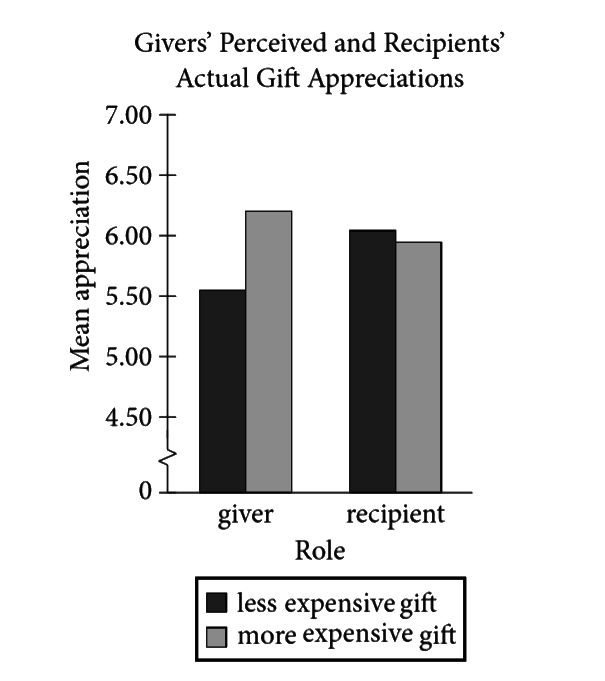
17. Which choice provides the best evidence for the answer to the previous question?ALines 53-55 (“Perhaps . . . consideration”)BLines 55-60 (“According . . . relationship”CLines 63-65 (“As . . . consideration”)DLines 75-78 (“In . . . relations”) 18Every day, millions of shoppers hit the stores in
full force—both online and on foot—searching
frantically for the perfect gift. Last year, Americans
spent over $30 billion at retail stores in the month of
5 December alone. Aside from purchasing holiday
gifts, most people regularly buy presents for other
occasions throughout the year, including weddings,
birthdays, anniversaries, graduations, and baby
showers. This frequent experience of gift-giving can
10 engender ambivalent feelings in gift-givers. Many
relish the opportunity to buy presents because
gift-giving offers a powerful means to build stronger
bonds with one’s closest peers. At the same time,
many dread the thought of buying gifts, they worry
15 that their purchases will disappoint rather than
delight the intended recipients.
Anthropologists describe gift-giving as a positive
social process, serving various political, religious, and
psychological functions. Economists, however, offer
20 a less favorable view. According to Waldfogel (1993),
gift-giving represents an objective waste of resources.
People buy gifts that recipients would not choose to
buy on their own, or at least not spend as much
money to purchase (a phenomenon referred to as
25 ‘‘the deadweight loss of Christmas”). To wit, givers
are likely to spend $100 to purchase a gift that
receivers would spend only $80 to buy themselves.
This ‘‘deadweight loss” suggests that gift-givers are
not very good at predicting what gifts others will
30 appreciate. That in itself is not surprising to social
psychologists. Research has found that people often
struggle to take account of others’ perspectives—
their insights are subject to egocentrism, social
projection, and multiple attribution errors.
35 What is surprising is that gift-givers have
considerable experience acting as both gift-givers and
gift-recipients, but nevertheless tend to overspend
each time they set out to purchase a meaningful gift.
In the present research, we propose a unique
40 psychological explanation for this overspending
problem—i.e., that gift-givers equate how much they
spend with how much recipients will appreciate the
gift (the more expensive the gift, the stronger a
gift-recipient’s feelings of appreciation). Although a
45 link between gift price and feelings of appreciation
might seem intuitive to gift-givers, such an
assumption may be unfounded. Indeed, we propose
that gift-recipients will be less inclined to base their
feelings of appreciation on the magnitude of a gift
50 than givers assume.
Why do gift-givers assume that gift price is closely
linked to gift-recipients’ feelings of appreciation?
Perhaps givers believe that bigger (i.e., more
expensive) gifts convey stronger signals of
55 thoughtfulness and consideration. According to
Camerer (1988) and others, gift-giving represents a
symbolic ritual, whereby gift-givers attempt to signal
their positive attitudes toward the intended recipient
and their willingness to invest resources in a future
60 relationship. In this sense, gift-givers may be
motivated to spend more money on a gift in order to
send a “stronger signal” to their intended recipient.
As for gift-recipients, they may not construe smaller
and larger gifts as representing smaller and larger
65 signals of thoughtfulness and consideration.
The notion of gift-givers and gift-recipients being
unable to account for the other party’s perspective
seems puzzling because people slip in and out of
these roles every day, and, in some cases, multiple
70 times in the course of the same day. Yet, despite the
extensive experience that people have as both givers
and receivers, they often struggle to transferinformation gained from one role (e.g., as a giver)
and apply it in another, complementary role (e.g., as
75 a receiver). In theoretical terms, people fail to utilize
information about their own preferences and
experiences in order to produce more efficient
outcomes in their exchange relations. In practical
terms, people spend hundreds of dollars each year on
gifts, but somehow never learn to calibrate their gift
expenditures according to personal insight.
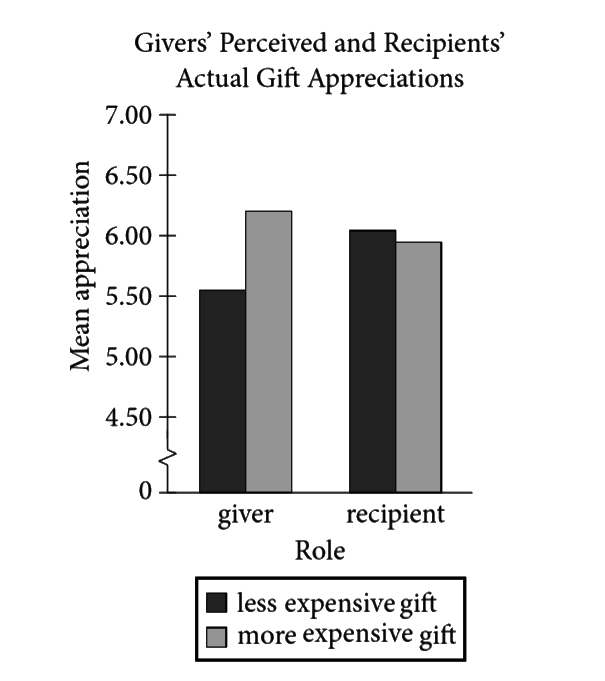
19. The authors refer to work by Camerer and others (line 56) in order toAoffer an explanation.Bintroduce an argumentCquestion a motive.Dsupport a conclusion.
If shoppers enter a store at an average rate of r shoppers per minute and each stays in the store for an average time of T minutes, the average number of shoppers in the store, N, at any one time is given by the formula N rT = . This relationship is known as Little’s law. The owner of the Good Deals Store estimates that during business hours, an average of 3 shoppers per minute enter the store and that each of them stays an average of 15 minutes. The store owner uses Little’s law to estimate that there are 45 shoppers in the store at any time.
Little’s law can be applied to any part of the store, such as a particular department or the checkout lines. The store owner determines that, during business hours, approximately 84 shoppers per hour make a purchase and each of these shoppers spend an average of 5 minutes in the checkout line. At any time during business hours, about how many shoppers, on average, are waiting in the checkout line to make a purchase at the Good Deals Store?
View SolutionFormulate the following problems as a pair of equations, and hence find their solutions:
(i) Ritu can row downstream 20 km in 2 hours, and upstream 4 km in 2 hours. Find her speed of rowing in still water and the speed of the current.
(ii) 2 women and 5 men can together finish an embroidery work in 4 days, while 3 women and 6 men can finish it in 3 days. Find the time taken by 1 woman alone to finish the work, and also that taken by 1 man alone.
(iii) Roohi travels 300 km to her home partly by train and partly by bus. She takes 4 hours if she travels 60 km by train and the remaining by bus. If she travels 100 km by train and the remaining by bus, she takes 10 minutes longer. Find the speed of the train and the bus separately.
View SolutionA square frame carrying a current I=0.90A is located in the same plane as a long straight wire carrying a current I0=5A, The frame side has a length a=8cm. The axis of the frame passing through the mid-point of the opposite sides is parrallel to the wire and is separated form it by a distance h=15 times greater tahn the side of the frame.
Find:
(a) ampere force acting on the frame.
(b) The machanical work to be performed in order to turn the frmae through 180∘ about its axis, with the current maintained constant.
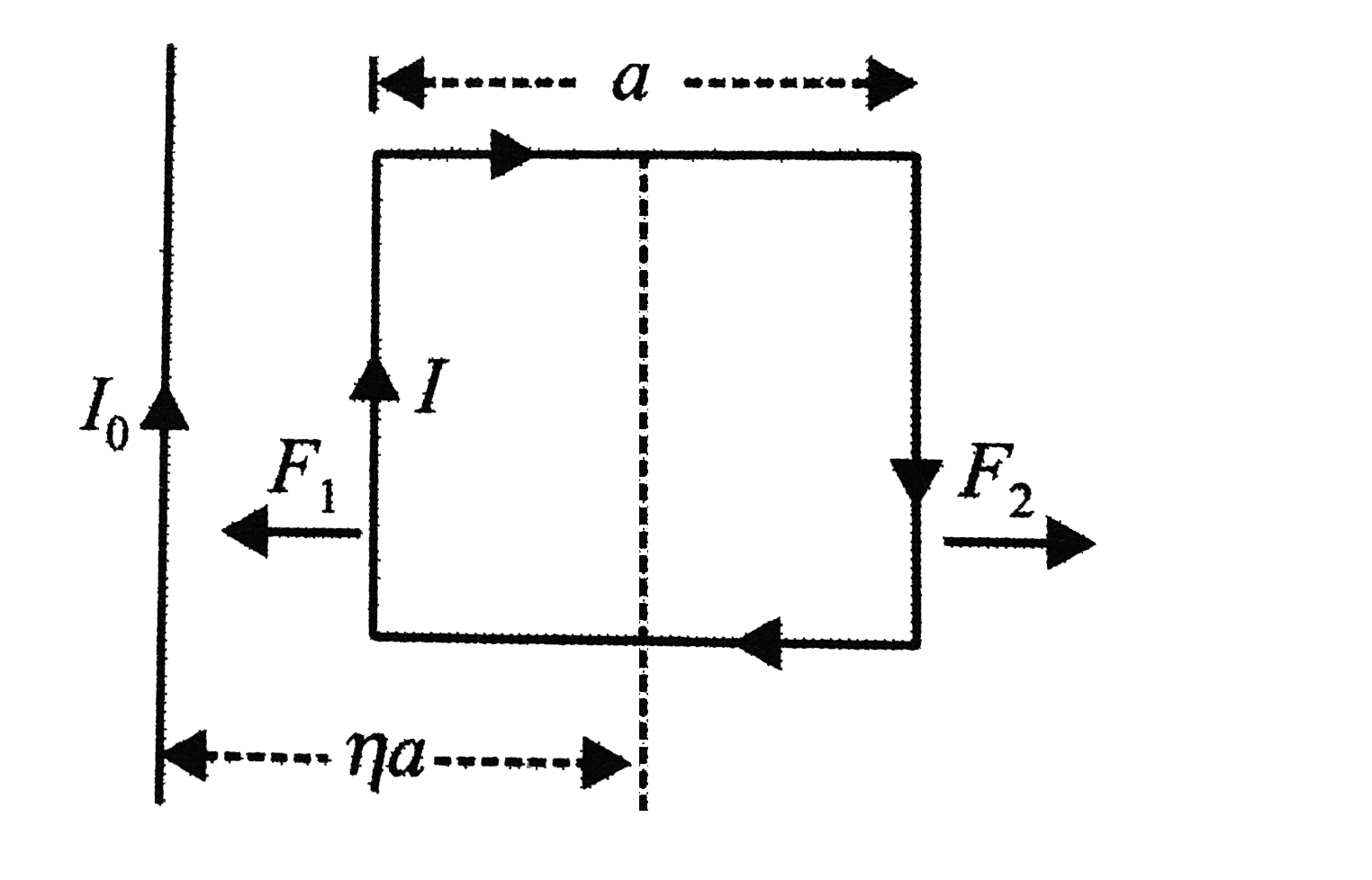
View SolutionEvery day, millions of shoppers hit the stores in
full force—both online and on foot—searching
frantically for the perfect gift. Last year, Americans
spent over $30 billion at retail stores in the month of
5 December alone. Aside from purchasing holiday
gifts, most people regularly buy presents for other
occasions throughout the year, including weddings,
birthdays, anniversaries, graduations, and baby
showers. This frequent experience of gift-giving can
10 engender ambivalent feelings in gift-givers. Many
relish the opportunity to buy presents because
gift-giving offers a powerful means to build stronger
bonds with one’s closest peers. At the same time,
many dread the thought of buying gifts, they worry
15 that their purchases will disappoint rather than
delight the intended recipients.
Anthropologists describe gift-giving as a positive
social process, serving various political, religious, and
psychological functions. Economists, however, offer
20 a less favorable view. According to Waldfogel (1993),
gift-giving represents an objective waste of resources.
People buy gifts that recipients would not choose to
buy on their own, or at least not spend as much
money to purchase (a phenomenon referred to as
25 ‘‘the deadweight loss of Christmas”). To wit, givers
are likely to spend $100 to purchase a gift that
receivers would spend only $80 to buy themselves.
This ‘‘deadweight loss” suggests that gift-givers are
not very good at predicting what gifts others will
30 appreciate. That in itself is not surprising to social
psychologists. Research has found that people often
struggle to take account of others’ perspectives—
their insights are subject to egocentrism, social
projection, and multiple attribution errors.
35 What is surprising is that gift-givers have
considerable experience acting as both gift-givers and
gift-recipients, but nevertheless tend to overspend
each time they set out to purchase a meaningful gift.
In the present research, we propose a unique
40 psychological explanation for this overspending
problem—i.e., that gift-givers equate how much they
spend with how much recipients will appreciate the
gift (the more expensive the gift, the stronger a
gift-recipient’s feelings of appreciation). Although a
45 link between gift price and feelings of appreciation
might seem intuitive to gift-givers, such an
assumption may be unfounded. Indeed, we propose
that gift-recipients will be less inclined to base their
feelings of appreciation on the magnitude of a gift
50 than givers assume.
Why do gift-givers assume that gift price is closely
linked to gift-recipients’ feelings of appreciation?
Perhaps givers believe that bigger (i.e., more
expensive) gifts convey stronger signals of
55 thoughtfulness and consideration. According to
Camerer (1988) and others, gift-giving represents a
symbolic ritual, whereby gift-givers attempt to signal
their positive attitudes toward the intended recipient
and their willingness to invest resources in a future
60 relationship. In this sense, gift-givers may be
motivated to spend more money on a gift in order to
send a “stronger signal” to their intended recipient.
As for gift-recipients, they may not construe smaller
and larger gifts as representing smaller and larger
65 signals of thoughtfulness and consideration.
The notion of gift-givers and gift-recipients being
unable to account for the other party’s perspective
seems puzzling because people slip in and out of
these roles every day, and, in some cases, multiple
70 times in the course of the same day. Yet, despite the
extensive experience that people have as both givers
and receivers, they often struggle to transferinformation gained from one role (e.g., as a giver)
and apply it in another, complementary role (e.g., as
75 a receiver). In theoretical terms, people fail to utilize
information about their own preferences and
experiences in order to produce more efficient
outcomes in their exchange relations. In practical
terms, people spend hundreds of dollars each year on
gifts, but somehow never learn to calibrate their gift
expenditures according to personal insight.
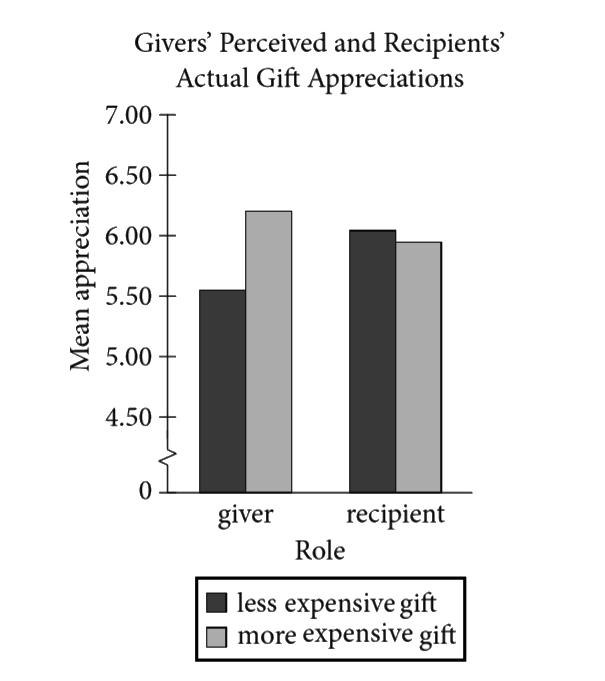
12. In line 10, the word “ambivalent” most nearly means
View SolutionEvery day, millions of shoppers hit the stores in
full force—both online and on foot—searching
frantically for the perfect gift. Last year, Americans
spent over $30 billion at retail stores in the month of
5 December alone. Aside from purchasing holiday
gifts, most people regularly buy presents for other
occasions throughout the year, including weddings,
birthdays, anniversaries, graduations, and baby
showers. This frequent experience of gift-giving can
10 engender ambivalent feelings in gift-givers. Many
relish the opportunity to buy presents because
gift-giving offers a powerful means to build stronger
bonds with one’s closest peers. At the same time,
many dread the thought of buying gifts, they worry
15 that their purchases will disappoint rather than
delight the intended recipients.
Anthropologists describe gift-giving as a positive
social process, serving various political, religious, and
psychological functions. Economists, however, offer
20 a less favorable view. According to Waldfogel (1993),
gift-giving represents an objective waste of resources.
People buy gifts that recipients would not choose to
buy on their own, or at least not spend as much
money to purchase (a phenomenon referred to as
25 ‘‘the deadweight loss of Christmas”). To wit, givers
are likely to spend $100 to purchase a gift that
receivers would spend only $80 to buy themselves.
This ‘‘deadweight loss” suggests that gift-givers are
not very good at predicting what gifts others will
30 appreciate. That in itself is not surprising to social
psychologists. Research has found that people often
struggle to take account of others’ perspectives—
their insights are subject to egocentrism, social
projection, and multiple attribution errors.
35 What is surprising is that gift-givers have
considerable experience acting as both gift-givers and
gift-recipients, but nevertheless tend to overspend
each time they set out to purchase a meaningful gift.
In the present research, we propose a unique
40 psychological explanation for this overspending
problem—i.e., that gift-givers equate how much they
spend with how much recipients will appreciate the
gift (the more expensive the gift, the stronger a
gift-recipient’s feelings of appreciation). Although a
45 link between gift price and feelings of appreciation
might seem intuitive to gift-givers, such an
assumption may be unfounded. Indeed, we propose
that gift-recipients will be less inclined to base their
feelings of appreciation on the magnitude of a gift
50 than givers assume.
Why do gift-givers assume that gift price is closely
linked to gift-recipients’ feelings of appreciation?
Perhaps givers believe that bigger (i.e., more
expensive) gifts convey stronger signals of
55 thoughtfulness and consideration. According to
Camerer (1988) and others, gift-giving represents a
symbolic ritual, whereby gift-givers attempt to signal
their positive attitudes toward the intended recipient
and their willingness to invest resources in a future
60 relationship. In this sense, gift-givers may be
motivated to spend more money on a gift in order to
send a “stronger signal” to their intended recipient.
As for gift-recipients, they may not construe smaller
and larger gifts as representing smaller and larger
65 signals of thoughtfulness and consideration.
The notion of gift-givers and gift-recipients being
unable to account for the other party’s perspective
seems puzzling because people slip in and out of
these roles every day, and, in some cases, multiple
70 times in the course of the same day. Yet, despite the
extensive experience that people have as both givers
and receivers, they often struggle to transferinformation gained from one role (e.g., as a giver)
and apply it in another, complementary role (e.g., as
75 a receiver). In theoretical terms, people fail to utilize
information about their own preferences and
experiences in order to produce more efficient
outcomes in their exchange relations. In practical
terms, people spend hundreds of dollars each year on
gifts, but somehow never learn to calibrate their gift
expenditures according to personal insight.
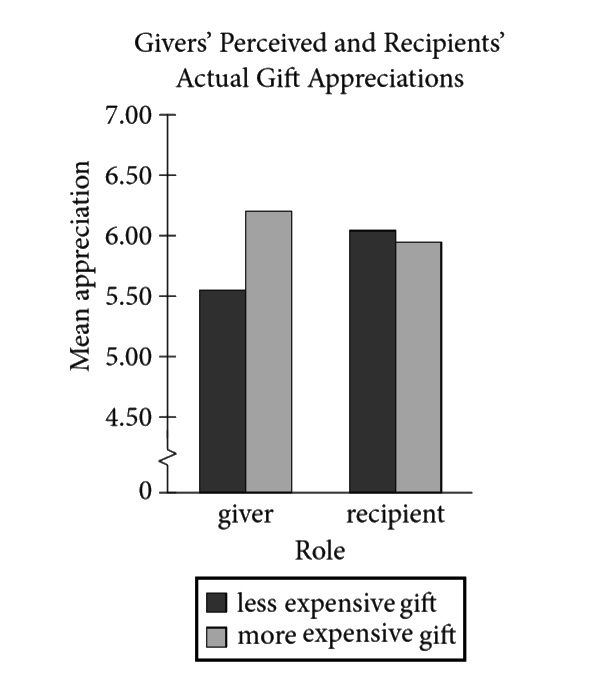
11. The authors most likely use the examples in lines 1-9of the passage (“Every . . .showers”) to highlight the
View Solution
